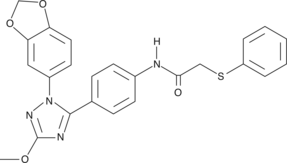Chemicals
Showing 35551–35700 of 41137 results
-
Se-Aspirin is a hybrid of selenium and a nonsteroidal anti-inflammatory drug that has been shown to reduce the viability of different cancer cell lines, particularly colorectal cancer (CRC) cells (IC50 = 3.4 µM).{31298} It can inhibit the cell cycle in G1 and G2/M phases and induce apoptosis by activating caspase 3/7 and PARP cleavage.{31298} Long-term exposure to Se-Aspirin is reported to cause an increase in intracellular reactive oxygen species levels in CRC cells.{31298}
Brand:CaymanSKU:-Available on backorder
SEA0400 is a selective inhibitor of the Na+/Ca2+ exchanger (IC50s = 5, 8.3, and 33 nM for inhibiting Na+-dependent Ca2+ uptake in rat astrocyte, microglia, and cortical neuron cell lines, respectively).{31853} It is reported to prevent dopaminergic neurotoxicity in an MPTP mouse model of Parkinson’s disease and to attenuate reperfusion injury in both in vitro and in vivo cerebral ischemic models.{31854,31852}
Brand:CaymanSKU:19876 -Available on backorder
SEA0400 is a selective inhibitor of the Na+/Ca2+ exchanger (IC50s = 5, 8.3, and 33 nM for inhibiting Na+-dependent Ca2+ uptake in rat astrocyte, microglia, and cortical neuron cell lines, respectively).{31853} It is reported to prevent dopaminergic neurotoxicity in an MPTP mouse model of Parkinson’s disease and to attenuate reperfusion injury in both in vitro and in vivo cerebral ischemic models.{31854,31852}
Brand:CaymanSKU:19876 -Available on backorder
SEA0400 is a selective inhibitor of the Na+/Ca2+ exchanger (IC50s = 5, 8.3, and 33 nM for inhibiting Na+-dependent Ca2+ uptake in rat astrocyte, microglia, and cortical neuron cell lines, respectively).{31853} It is reported to prevent dopaminergic neurotoxicity in an MPTP mouse model of Parkinson’s disease and to attenuate reperfusion injury in both in vitro and in vivo cerebral ischemic models.{31854,31852}
Brand:CaymanSKU:19876 -Available on backorder
SEA0400 is a selective inhibitor of the Na+/Ca2+ exchanger (IC50s = 5, 8.3, and 33 nM for inhibiting Na+-dependent Ca2+ uptake in rat astrocyte, microglia, and cortical neuron cell lines, respectively).{31853} It is reported to prevent dopaminergic neurotoxicity in an MPTP mouse model of Parkinson’s disease and to attenuate reperfusion injury in both in vitro and in vivo cerebral ischemic models.{31854,31852}
Brand:CaymanSKU:19876 -Available on backorder
Cytohesins are small guanine nucleotide exchange factors (GEFs) that stimulate adenosine diphosphate ribosylation factors (Arfs), GTPases which control signal transduction along various intracellular pathways.{25737} SecinH3 is a selective inhibitor of cytohesins, blocking human, mouse, and Drosophila cytohesins with IC50 values of 2.4 to 5.6 µM.{14565} It binds the Sec7 domain of these small Arf-GEFs but does not bind Sec7 domains of larger Arf-GEFs.{25739} In human liver carcinoma HepG2 cells, SecinH3 prevents cytohesin-dependent insulin signaling.{14565} In mice, SecinH3 produces hepatic insulin resistance.{14565} Inhibition of the cytohesin GEF from Drosophila, Steppke, blocks insulin signaling and interferes with development.{25736} SecinH3 is useful for studying the diverse roles of cytohesins, including the regulation of receptor-mediated cancer cell proliferation.{25738}
Brand:CaymanSKU:10009570 - 1 mgAvailable on backorder
Cytohesins are small guanine nucleotide exchange factors (GEFs) that stimulate adenosine diphosphate ribosylation factors (Arfs), GTPases which control signal transduction along various intracellular pathways.{25737} SecinH3 is a selective inhibitor of cytohesins, blocking human, mouse, and Drosophila cytohesins with IC50 values of 2.4 to 5.6 µM.{14565} It binds the Sec7 domain of these small Arf-GEFs but does not bind Sec7 domains of larger Arf-GEFs.{25739} In human liver carcinoma HepG2 cells, SecinH3 prevents cytohesin-dependent insulin signaling.{14565} In mice, SecinH3 produces hepatic insulin resistance.{14565} Inhibition of the cytohesin GEF from Drosophila, Steppke, blocks insulin signaling and interferes with development.{25736} SecinH3 is useful for studying the diverse roles of cytohesins, including the regulation of receptor-mediated cancer cell proliferation.{25738}
Brand:CaymanSKU:10009570 - 10 mgAvailable on backorder
Cytohesins are small guanine nucleotide exchange factors (GEFs) that stimulate adenosine diphosphate ribosylation factors (Arfs), GTPases which control signal transduction along various intracellular pathways.{25737} SecinH3 is a selective inhibitor of cytohesins, blocking human, mouse, and Drosophila cytohesins with IC50 values of 2.4 to 5.6 µM.{14565} It binds the Sec7 domain of these small Arf-GEFs but does not bind Sec7 domains of larger Arf-GEFs.{25739} In human liver carcinoma HepG2 cells, SecinH3 prevents cytohesin-dependent insulin signaling.{14565} In mice, SecinH3 produces hepatic insulin resistance.{14565} Inhibition of the cytohesin GEF from Drosophila, Steppke, blocks insulin signaling and interferes with development.{25736} SecinH3 is useful for studying the diverse roles of cytohesins, including the regulation of receptor-mediated cancer cell proliferation.{25738}
Brand:CaymanSKU:10009570 - 25 mgAvailable on backorder
Cytohesins are small guanine nucleotide exchange factors (GEFs) that stimulate adenosine diphosphate ribosylation factors (Arfs), GTPases which control signal transduction along various intracellular pathways.{25737} SecinH3 is a selective inhibitor of cytohesins, blocking human, mouse, and Drosophila cytohesins with IC50 values of 2.4 to 5.6 µM.{14565} It binds the Sec7 domain of these small Arf-GEFs but does not bind Sec7 domains of larger Arf-GEFs.{25739} In human liver carcinoma HepG2 cells, SecinH3 prevents cytohesin-dependent insulin signaling.{14565} In mice, SecinH3 produces hepatic insulin resistance.{14565} Inhibition of the cytohesin GEF from Drosophila, Steppke, blocks insulin signaling and interferes with development.{25736} SecinH3 is useful for studying the diverse roles of cytohesins, including the regulation of receptor-mediated cancer cell proliferation.{25738}
Brand:CaymanSKU:10009570 - 5 mgAvailable on backorder
Secnidazole is a 5-nitroimidazole derivative with antiparasitic and antibiotic activity.{33259,26702} It exhibits a mean minimum inhibitory concentration of 2.59 µM against 16 clinical isolates of B. fragilis.{26702} It shows efficacy against ameobiasis, giardiasis, H. pylori and other parasites and microbes.{33259,33283,33281,33280,33282}
Brand:CaymanSKU:21236 -Out of stock
Secnidazole is a 5-nitroimidazole derivative with antiparasitic and antibiotic activity.{33259,26702} It exhibits a mean minimum inhibitory concentration of 2.59 µM against 16 clinical isolates of B. fragilis.{26702} It shows efficacy against ameobiasis, giardiasis, H. pylori and other parasites and microbes.{33259,33283,33281,33280,33282}
Brand:CaymanSKU:21236 -Out of stock
Secnidazole is a 5-nitroimidazole derivative with antiparasitic and antibiotic activity.{33259,26702} It exhibits a mean minimum inhibitory concentration of 2.59 µM against 16 clinical isolates of B. fragilis.{26702} It shows efficacy against ameobiasis, giardiasis, H. pylori and other parasites and microbes.{33259,33283,33281,33280,33282}
Brand:CaymanSKU:21236 -Out of stock
Rapamycin (Item No. 13346) is a natural macrolide immunosuppressant that activates mTORC1. Seco Rapamycin (sodium salt) is a nonenzyme-dependent degradation product of rapamycin (Item No. 13346) resulting from ester hydration followed by dehydration.{26501} It has less than 4% of the potency of rapamycin in a thymocyte proliferation assay.{26501} Rapamycin quickly degrades to two ring-opened products, including seco rapamycin, in the cytoplasm or in homogenates of Caco-2 cells.{26499} Like rapamycin, seco rapamycin is secreted from cells by P-glycoprotein and metabolized to a common dihydro species.{26500} While seco rapamycin poorly activates mTOR, it mimics rapamycin in its ability to inhibit the proteasome.{26502}
Brand:CaymanSKU:-Rapamycin (Item No. 13346) is a natural macrolide immunosuppressant that activates mTORC1. Seco Rapamycin (sodium salt) is a nonenzyme-dependent degradation product of rapamycin (Item No. 13346) resulting from ester hydration followed by dehydration.{26501} It has less than 4% of the potency of rapamycin in a thymocyte proliferation assay.{26501} Rapamycin quickly degrades to two ring-opened products, including seco rapamycin, in the cytoplasm or in homogenates of Caco-2 cells.{26499} Like rapamycin, seco rapamycin is secreted from cells by P-glycoprotein and metabolized to a common dihydro species.{26500} While seco rapamycin poorly activates mTOR, it mimics rapamycin in its ability to inhibit the proteasome.{26502}
Brand:CaymanSKU:-Rapamycin (Item No. 13346) is a natural macrolide immunosuppressant that activates mTORC1. Seco Rapamycin (sodium salt) is a nonenzyme-dependent degradation product of rapamycin (Item No. 13346) resulting from ester hydration followed by dehydration.{26501} It has less than 4% of the potency of rapamycin in a thymocyte proliferation assay.{26501} Rapamycin quickly degrades to two ring-opened products, including seco rapamycin, in the cytoplasm or in homogenates of Caco-2 cells.{26499} Like rapamycin, seco rapamycin is secreted from cells by P-glycoprotein and metabolized to a common dihydro species.{26500} While seco rapamycin poorly activates mTOR, it mimics rapamycin in its ability to inhibit the proteasome.{26502}
Brand:CaymanSKU:-Secoisolariciresinol diglucoside (SDG) is a lignan that has been found in flaxseed with antioxidant, antiproliferative, antidiabetic, and cardioprotective biological activities.{41788,41789,41790,41791,41792,41793} It scavenges 2,2-diphenyl-1-picrylhydrazyl (DPPH; Item No. 14805) radicals (IC50 = 78.9 μg/ml) in a cell-free assay and dose-dependently inhibits the growth of SW480 human colon cancer cells in vitro.{41789,41790} Dietary administration of SDG reduces the number of proliferating tumor cells in an MCF-7 human breast cancer mouse xenograft model in the presence of circulating estrogen.{41791} It also increases insulin and decreases glucose serum levels in rats with diabetes induced by streptozotocin (Item No. 13104) when administered at a dose of 20 mg/kg.{41792} SDG (20 mg/kg per day) decreases infarct size in rats with myocardial infarction induced by permanent occlusion of the left anterior descending coronary artery.{41793}
Brand:CaymanSKU:24974 - 10 mgAvailable on backorder
Secoisolariciresinol diglucoside (SDG) is a lignan that has been found in flaxseed with antioxidant, antiproliferative, antidiabetic, and cardioprotective biological activities.{41788,41789,41790,41791,41792,41793} It scavenges 2,2-diphenyl-1-picrylhydrazyl (DPPH; Item No. 14805) radicals (IC50 = 78.9 μg/ml) in a cell-free assay and dose-dependently inhibits the growth of SW480 human colon cancer cells in vitro.{41789,41790} Dietary administration of SDG reduces the number of proliferating tumor cells in an MCF-7 human breast cancer mouse xenograft model in the presence of circulating estrogen.{41791} It also increases insulin and decreases glucose serum levels in rats with diabetes induced by streptozotocin (Item No. 13104) when administered at a dose of 20 mg/kg.{41792} SDG (20 mg/kg per day) decreases infarct size in rats with myocardial infarction induced by permanent occlusion of the left anterior descending coronary artery.{41793}
Brand:CaymanSKU:24974 - 100 mgAvailable on backorder
Secoisolariciresinol diglucoside (SDG) is a lignan that has been found in flaxseed with antioxidant, antiproliferative, antidiabetic, and cardioprotective biological activities.{41788,41789,41790,41791,41792,41793} It scavenges 2,2-diphenyl-1-picrylhydrazyl (DPPH; Item No. 14805) radicals (IC50 = 78.9 μg/ml) in a cell-free assay and dose-dependently inhibits the growth of SW480 human colon cancer cells in vitro.{41789,41790} Dietary administration of SDG reduces the number of proliferating tumor cells in an MCF-7 human breast cancer mouse xenograft model in the presence of circulating estrogen.{41791} It also increases insulin and decreases glucose serum levels in rats with diabetes induced by streptozotocin (Item No. 13104) when administered at a dose of 20 mg/kg.{41792} SDG (20 mg/kg per day) decreases infarct size in rats with myocardial infarction induced by permanent occlusion of the left anterior descending coronary artery.{41793}
Brand:CaymanSKU:24974 - 50 mgAvailable on backorder
Secologanin is a monoterpene that has been found in V. rosea and is an intermediate in the synthesis of monoterpene indole alkaloids from geraniol.{43488,43489} It is a metabolite of loganin (Item No. 19997) formed by the cytochrome P450 (CYP) isoform CYP72A1, also known as secologanin synthase.{32244}
Brand:CaymanSKU:20647 -Available on backorder
Secologanin is a monoterpene that has been found in V. rosea and is an intermediate in the synthesis of monoterpene indole alkaloids from geraniol.{43488,43489} It is a metabolite of loganin (Item No. 19997) formed by the cytochrome P450 (CYP) isoform CYP72A1, also known as secologanin synthase.{32244}
Brand:CaymanSKU:20647 -Available on backorder
Secoxyloganin is a secoiridoid glycoside that has been found in L. japonica and has diverse biological activities.{53646,53647,53648} It is active against E. coli and S. aureus in a disc assay when used at a concentration of 2 mg/disc.{53646} Secoxyloganin is cytotoxic to human dermal fibroblasts (IC50 = 78.1 µM).{53647} In vivo, secoxyloganin (10 mg/ml) prevents hen egg white lysozyme-induced decreases in tail vein blood flow, a marker of allergic inflammation, in hen egg white lysozyme-sensitized mice.{53648}
Brand:CaymanSKU:30267 - 1 mgAvailable on backorder
Secoxyloganin is a secoiridoid glycoside that has been found in L. japonica and has diverse biological activities.{53646,53647,53648} It is active against E. coli and S. aureus in a disc assay when used at a concentration of 2 mg/disc.{53646} Secoxyloganin is cytotoxic to human dermal fibroblasts (IC50 = 78.1 µM).{53647} In vivo, secoxyloganin (10 mg/ml) prevents hen egg white lysozyme-induced decreases in tail vein blood flow, a marker of allergic inflammation, in hen egg white lysozyme-sensitized mice.{53648}
Brand:CaymanSKU:30267 - 10 mgAvailable on backorder
Secoxyloganin is a secoiridoid glycoside that has been found in L. japonica and has diverse biological activities.{53646,53647,53648} It is active against E. coli and S. aureus in a disc assay when used at a concentration of 2 mg/disc.{53646} Secoxyloganin is cytotoxic to human dermal fibroblasts (IC50 = 78.1 µM).{53647} In vivo, secoxyloganin (10 mg/ml) prevents hen egg white lysozyme-induced decreases in tail vein blood flow, a marker of allergic inflammation, in hen egg white lysozyme-sensitized mice.{53648}
Brand:CaymanSKU:30267 - 25 mgAvailable on backorder
Secoxyloganin is a secoiridoid glycoside that has been found in L. japonica and has diverse biological activities.{53646,53647,53648} It is active against E. coli and S. aureus in a disc assay when used at a concentration of 2 mg/disc.{53646} Secoxyloganin is cytotoxic to human dermal fibroblasts (IC50 = 78.1 µM).{53647} In vivo, secoxyloganin (10 mg/ml) prevents hen egg white lysozyme-induced decreases in tail vein blood flow, a marker of allergic inflammation, in hen egg white lysozyme-sensitized mice.{53648}
Brand:CaymanSKU:30267 - 5 mgAvailable on backorder
Secretin is a neuropeptide hormone that regulates secretion from the stomach, pancreas, and liver.{38733,38734} It binds to the rat secretin receptor (SCT-R; Ki = 3.3 nM) and increases intracellular cAMP (EC50 = 1 nM) in COS cells expressing rat SCT-R.{38735} It also increases SCT-R phosphorylation 7.2-fold at a concentration of 0.1 μM. Secretin dose-dependently increases the volume of pancreatic secretion and inhibits gastric acid secretion induced by gastrin I (Item No. 24457) in rats when administered at a dose of 100 pmol/kg per hour.{38736}
Brand:CaymanSKU:24561 - 1 mgAvailable on backorder
Sedanolide is a natural phthalide first isolated from seed oil of the Umbelliferae family, including celery. It induces the expression of glutathione S-transferase and reduces chemical-induced carcinogenesis in mice.{28317} Sedanolide inhibits cyclooxygenases-1 and -2 at 250 pg/ml and blocks topoisomerase-I and-II activity at 100 µg/ml.{28315} It is mosquitocidal, nematicidal, and antifungal but shows no cytotoxicity against normal mammalian cells.{28314,28316}
Brand:CaymanSKU:-Out of stock
Sedanolide is a natural phthalide first isolated from seed oil of the Umbelliferae family, including celery. It induces the expression of glutathione S-transferase and reduces chemical-induced carcinogenesis in mice.{28317} Sedanolide inhibits cyclooxygenases-1 and -2 at 250 pg/ml and blocks topoisomerase-I and-II activity at 100 µg/ml.{28315} It is mosquitocidal, nematicidal, and antifungal but shows no cytotoxicity against normal mammalian cells.{28314,28316}
Brand:CaymanSKU:-Out of stock
Sedanolide is a natural phthalide first isolated from seed oil of the Umbelliferae family, including celery. It induces the expression of glutathione S-transferase and reduces chemical-induced carcinogenesis in mice.{28317} Sedanolide inhibits cyclooxygenases-1 and -2 at 250 pg/ml and blocks topoisomerase-I and-II activity at 100 µg/ml.{28315} It is mosquitocidal, nematicidal, and antifungal but shows no cytotoxicity against normal mammalian cells.{28314,28316}
Brand:CaymanSKU:-Out of stock
Segesterone acetate is a synthetic progestin that binds to the progesterone receptor (EC50 = 50.3 nM).{48067} It increases uterine weight in rabbits (ED50 = ~1 µg), maintains pregnancy in 40-50% of rats when administered at doses ranging from 0.03 to 0.1 mg per day, and completely inhibits spontaneous ovulation in rats at a dose of 10 µg per day. It also binds to the glucocorticoid receptor (EC50 = 56 nM) but does not have in vivo glucocorticoid activity. Segesterone acetate (8 µg, i.c.v., via osmotic minipump over four weeks) increases cell proliferation in the adult female mouse brain, increasing the production of new neurons and oligodendrocytes.{48068} Sustained-release formulations containing segesterone have been used as contraceptives.
Brand:CaymanSKU:26441 - 10 mgAvailable on backorder
Segesterone acetate is a synthetic progestin that binds to the progesterone receptor (EC50 = 50.3 nM).{48067} It increases uterine weight in rabbits (ED50 = ~1 µg), maintains pregnancy in 40-50% of rats when administered at doses ranging from 0.03 to 0.1 mg per day, and completely inhibits spontaneous ovulation in rats at a dose of 10 µg per day. It also binds to the glucocorticoid receptor (EC50 = 56 nM) but does not have in vivo glucocorticoid activity. Segesterone acetate (8 µg, i.c.v., via osmotic minipump over four weeks) increases cell proliferation in the adult female mouse brain, increasing the production of new neurons and oligodendrocytes.{48068} Sustained-release formulations containing segesterone have been used as contraceptives.
Brand:CaymanSKU:26441 - 25 mgAvailable on backorder
Segesterone acetate is a synthetic progestin that binds to the progesterone receptor (EC50 = 50.3 nM).{48067} It increases uterine weight in rabbits (ED50 = ~1 µg), maintains pregnancy in 40-50% of rats when administered at doses ranging from 0.03 to 0.1 mg per day, and completely inhibits spontaneous ovulation in rats at a dose of 10 µg per day. It also binds to the glucocorticoid receptor (EC50 = 56 nM) but does not have in vivo glucocorticoid activity. Segesterone acetate (8 µg, i.c.v., via osmotic minipump over four weeks) increases cell proliferation in the adult female mouse brain, increasing the production of new neurons and oligodendrocytes.{48068} Sustained-release formulations containing segesterone have been used as contraceptives.
Brand:CaymanSKU:26441 - 5 mgAvailable on backorder
Selamectin is a macrocyclic lactone derivative of ivermectin, an anthelmintic that potentiates glutamate- and GABA-gated chloride channel opening in nematodes.{31084,31087} At 0.1 µg/ml, selamectin is reported to inhibit growth in an H. contortus larval development assay.{31087}
Brand:CaymanSKU:21529 -Out of stock
Selamectin is a macrocyclic lactone derivative of ivermectin, an anthelmintic that potentiates glutamate- and GABA-gated chloride channel opening in nematodes.{31084,31087} At 0.1 µg/ml, selamectin is reported to inhibit growth in an H. contortus larval development assay.{31087}
Brand:CaymanSKU:21529 -Out of stock
Selamectin is a macrocyclic lactone derivative of ivermectin, an anthelmintic that potentiates glutamate- and GABA-gated chloride channel opening in nematodes.{31084,31087} At 0.1 µg/ml, selamectin is reported to inhibit growth in an H. contortus larval development assay.{31087}
Brand:CaymanSKU:21529 -Out of stock
Selamectin is a macrocyclic lactone derivative of ivermectin, an anthelmintic that potentiates glutamate- and GABA-gated chloride channel opening in nematodes.{31084,31087} At 0.1 µg/ml, selamectin is reported to inhibit growth in an H. contortus larval development assay.{31087}
Brand:CaymanSKU:21529 -Out of stock
Selonsertib is an orally bioavailable inhibitor of apoptosis signal-regulating kinase 1 (ASK1; IC50 = 3.2 nM), which is involved in a variety of conditions, including fibrosis, oxidative stress, and inflammation, among others.{34693} A formulation containing selonsertib showed antifibrotic activity in a Phase II clinical trial. Clinical trials are ongoing for other conditions, including severe alcoholic hepatitis and nonalcoholic steatohepatitis.
Brand:CaymanSKU:20972 -Out of stock
Selonsertib is an orally bioavailable inhibitor of apoptosis signal-regulating kinase 1 (ASK1; IC50 = 3.2 nM), which is involved in a variety of conditions, including fibrosis, oxidative stress, and inflammation, among others.{34693} A formulation containing selonsertib showed antifibrotic activity in a Phase II clinical trial. Clinical trials are ongoing for other conditions, including severe alcoholic hepatitis and nonalcoholic steatohepatitis.
Brand:CaymanSKU:20972 -Out of stock
Selonsertib is an orally bioavailable inhibitor of apoptosis signal-regulating kinase 1 (ASK1; IC50 = 3.2 nM), which is involved in a variety of conditions, including fibrosis, oxidative stress, and inflammation, among others.{34693} A formulation containing selonsertib showed antifibrotic activity in a Phase II clinical trial. Clinical trials are ongoing for other conditions, including severe alcoholic hepatitis and nonalcoholic steatohepatitis.
Brand:CaymanSKU:20972 -Out of stock
Selonsertib is an orally bioavailable inhibitor of apoptosis signal-regulating kinase 1 (ASK1; IC50 = 3.2 nM), which is involved in a variety of conditions, including fibrosis, oxidative stress, and inflammation, among others.{34693} A formulation containing selonsertib showed antifibrotic activity in a Phase II clinical trial. Clinical trials are ongoing for other conditions, including severe alcoholic hepatitis and nonalcoholic steatohepatitis.
Brand:CaymanSKU:20972 -Out of stock
Semagacestat is a potent inhibitor of γ-secretase that blocks the production of Aβ38, Aβ40, and Aβ42 with IC50 values of 12.0, 12.1, and 10.9 nM, respectively.{27630,27426} It also blocks Notch signaling (IC50 = 14.1 nM).{27426} Semagacestat modulates γ-secretase activity in vivo, altering Aβ levels in brain, cerebrospinal fluids, and plasma in a dose-dependent fashion.{27630,27426} Although semagacestat does not improve cognitive status in humans, it is useful as a pan γ-secretase inhibitor for research purposes.{27426,27631}
Brand:CaymanSKU:-Out of stock
Semagacestat is a potent inhibitor of γ-secretase that blocks the production of Aβ38, Aβ40, and Aβ42 with IC50 values of 12.0, 12.1, and 10.9 nM, respectively.{27630,27426} It also blocks Notch signaling (IC50 = 14.1 nM).{27426} Semagacestat modulates γ-secretase activity in vivo, altering Aβ levels in brain, cerebrospinal fluids, and plasma in a dose-dependent fashion.{27630,27426} Although semagacestat does not improve cognitive status in humans, it is useful as a pan γ-secretase inhibitor for research purposes.{27426,27631}
Brand:CaymanSKU:-Out of stock
Semagacestat is a potent inhibitor of γ-secretase that blocks the production of Aβ38, Aβ40, and Aβ42 with IC50 values of 12.0, 12.1, and 10.9 nM, respectively.{27630,27426} It also blocks Notch signaling (IC50 = 14.1 nM).{27426} Semagacestat modulates γ-secretase activity in vivo, altering Aβ levels in brain, cerebrospinal fluids, and plasma in a dose-dependent fashion.{27630,27426} Although semagacestat does not improve cognitive status in humans, it is useful as a pan γ-secretase inhibitor for research purposes.{27426,27631}
Brand:CaymanSKU:-Out of stock
Semagacestat is a potent inhibitor of γ-secretase that blocks the production of Aβ38, Aβ40, and Aβ42 with IC50 values of 12.0, 12.1, and 10.9 nM, respectively.{27630,27426} It also blocks Notch signaling (IC50 = 14.1 nM).{27426} Semagacestat modulates γ-secretase activity in vivo, altering Aβ levels in brain, cerebrospinal fluids, and plasma in a dose-dependent fashion.{27630,27426} Although semagacestat does not improve cognitive status in humans, it is useful as a pan γ-secretase inhibitor for research purposes.{27426,27631}
Brand:CaymanSKU:-Out of stock
Sematilide is a class III antiarrhythmic agent and an analog of sotalol (Item No. 16136).{42876} It prolongs electrically stimulated action potential duration (APD) and increases the effective refractory period (ERP) in isolated guinea pig left atria. Sematilide decreases spontaneous sinoatrial beating rates and induces ERP prolongation of the atrioventricular node in isolated perfused canine hearts.{42877} In situ, sematilide (1 mg/kg) increases ERP, prolonging cardiac refractoriness, in open-chest dog hearts. Sematilide (0.3-6 mg/kg) inhibits arrhythmias induced by programmed electrical stimulation (PES), but not coronary ligation and reperfusion, two-stage coronary ligation, adrenaline, or digitalis, in dogs.{42878} Formulations containing sematilide have been used in the treatment of arrhythmias.
Brand:CaymanSKU:28272 - 10 mgAvailable on backorder
Sematilide is a class III antiarrhythmic agent and an analog of sotalol (Item No. 16136).{42876} It prolongs electrically stimulated action potential duration (APD) and increases the effective refractory period (ERP) in isolated guinea pig left atria. Sematilide decreases spontaneous sinoatrial beating rates and induces ERP prolongation of the atrioventricular node in isolated perfused canine hearts.{42877} In situ, sematilide (1 mg/kg) increases ERP, prolonging cardiac refractoriness, in open-chest dog hearts. Sematilide (0.3-6 mg/kg) inhibits arrhythmias induced by programmed electrical stimulation (PES), but not coronary ligation and reperfusion, two-stage coronary ligation, adrenaline, or digitalis, in dogs.{42878} Formulations containing sematilide have been used in the treatment of arrhythmias.
Brand:CaymanSKU:28272 - 25 mgAvailable on backorder
Sematilide is a class III antiarrhythmic agent and an analog of sotalol (Item No. 16136).{42876} It prolongs electrically stimulated action potential duration (APD) and increases the effective refractory period (ERP) in isolated guinea pig left atria. Sematilide decreases spontaneous sinoatrial beating rates and induces ERP prolongation of the atrioventricular node in isolated perfused canine hearts.{42877} In situ, sematilide (1 mg/kg) increases ERP, prolonging cardiac refractoriness, in open-chest dog hearts. Sematilide (0.3-6 mg/kg) inhibits arrhythmias induced by programmed electrical stimulation (PES), but not coronary ligation and reperfusion, two-stage coronary ligation, adrenaline, or digitalis, in dogs.{42878} Formulations containing sematilide have been used in the treatment of arrhythmias.
Brand:CaymanSKU:28272 - 5 mgAvailable on backorder
Sematilide is a class III antiarrhythmic agent and an analog of sotalol (Item No. 16136).{42876} It prolongs electrically stimulated action potential duration (APD) and increases the effective refractory period (ERP) in isolated guinea pig left atria. Sematilide decreases spontaneous sinoatrial beating rates and induces ERP prolongation of the atrioventricular node in isolated perfused canine hearts.{42877} In situ, sematilide (1 mg/kg) increases ERP, prolonging cardiac refractoriness, in open-chest dog hearts. Sematilide (0.3-6 mg/kg) inhibits arrhythmias induced by programmed electrical stimulation (PES), but not coronary ligation and reperfusion, two-stage coronary ligation, adrenaline, or digitalis, in dogs.{42878} Formulations containing sematilide have been used in the treatment of arrhythmias.
Brand:CaymanSKU:28272 - 50 mgAvailable on backorder
Semax is a synthetic peptide analog of adrenocorticotropic hormone (ACTH) (4-10) (Item No. 27106) that has neuroprotective, analgesic, and anxiolytic properties.{50308,50309,50310} In vivo, semax (0.3 mg/kg) reduces cortical nitric oxide (NO) production and the number of neurological disturbances, such as seizures, falling, and twisting, in a rat model of global ischemia.{50308} It decreases acetic acid-induced writhing and nociception in a hind paw compression test in mice when administered at doses ranging from 0.015 to 0.5 mg/kg.{50309} Semax also increases time spent in the open arms in the elevated plus maze, indicating anxiolytic activity, in a rat model of maternal deprivation-induced anxiety.{50310}
Brand:CaymanSKU:27719 - 1 mgAvailable on backorder
Semax is a synthetic peptide analog of adrenocorticotropic hormone (ACTH) (4-10) (Item No. 27106) that has neuroprotective, analgesic, and anxiolytic properties.{50308,50309,50310} In vivo, semax (0.3 mg/kg) reduces cortical nitric oxide (NO) production and the number of neurological disturbances, such as seizures, falling, and twisting, in a rat model of global ischemia.{50308} It decreases acetic acid-induced writhing and nociception in a hind paw compression test in mice when administered at doses ranging from 0.015 to 0.5 mg/kg.{50309} Semax also increases time spent in the open arms in the elevated plus maze, indicating anxiolytic activity, in a rat model of maternal deprivation-induced anxiety.{50310}
Brand:CaymanSKU:27719 - 10 mgAvailable on backorder
Semax is a synthetic peptide analog of adrenocorticotropic hormone (ACTH) (4-10) (Item No. 27106) that has neuroprotective, analgesic, and anxiolytic properties.{50308,50309,50310} In vivo, semax (0.3 mg/kg) reduces cortical nitric oxide (NO) production and the number of neurological disturbances, such as seizures, falling, and twisting, in a rat model of global ischemia.{50308} It decreases acetic acid-induced writhing and nociception in a hind paw compression test in mice when administered at doses ranging from 0.015 to 0.5 mg/kg.{50309} Semax also increases time spent in the open arms in the elevated plus maze, indicating anxiolytic activity, in a rat model of maternal deprivation-induced anxiety.{50310}
Brand:CaymanSKU:27719 - 5 mgAvailable on backorder
Senecionine is a pyrrolizidine alkaloid that has been found in S. vulgaris and has hepatotoxic properties.{48022} It is metabolized by the cytochrome P450 (CYP) isoform CYP3A in the liver to the detoxification product senecionine N-oxide and reactive metabolites including dehydropyrrolizidine alkaloids and dehydrotetronecine.{48023,48024} Senecionine (20 μM) induces mitochondrial depolarization and fragmentation in primary cultured mouse hepatocytes and increases apoptosis in a concentration-dependent manner.{48023} In rats, senecionine (35 mg/kg, p.o.) induces liver injury, increases serum levels of bilirubin (Item No. 17161) and various bile acids, including taurocholic acid, glycocholic acid, and deoxycholic acid, and increases the activity of alanine aminotransferase and aspartate aminotransferase in serum.{48022} Senecionine-induced hepatotoxicity is associated with lipid peroxidation and glutathione depletion.
Brand:CaymanSKU:25145 - 1 mgAvailable on backorder
Senecionine is a pyrrolizidine alkaloid that has been found in S. vulgaris and has hepatotoxic properties.{48022} It is metabolized by the cytochrome P450 (CYP) isoform CYP3A in the liver to the detoxification product senecionine N-oxide and reactive metabolites including dehydropyrrolizidine alkaloids and dehydrotetronecine.{48023,48024} Senecionine (20 μM) induces mitochondrial depolarization and fragmentation in primary cultured mouse hepatocytes and increases apoptosis in a concentration-dependent manner.{48023} In rats, senecionine (35 mg/kg, p.o.) induces liver injury, increases serum levels of bilirubin (Item No. 17161) and various bile acids, including taurocholic acid, glycocholic acid, and deoxycholic acid, and increases the activity of alanine aminotransferase and aspartate aminotransferase in serum.{48022} Senecionine-induced hepatotoxicity is associated with lipid peroxidation and glutathione depletion.
Brand:CaymanSKU:25145 - 10 mgAvailable on backorder
Senecionine is a pyrrolizidine alkaloid that has been found in S. vulgaris and has hepatotoxic properties.{48022} It is metabolized by the cytochrome P450 (CYP) isoform CYP3A in the liver to the detoxification product senecionine N-oxide and reactive metabolites including dehydropyrrolizidine alkaloids and dehydrotetronecine.{48023,48024} Senecionine (20 μM) induces mitochondrial depolarization and fragmentation in primary cultured mouse hepatocytes and increases apoptosis in a concentration-dependent manner.{48023} In rats, senecionine (35 mg/kg, p.o.) induces liver injury, increases serum levels of bilirubin (Item No. 17161) and various bile acids, including taurocholic acid, glycocholic acid, and deoxycholic acid, and increases the activity of alanine aminotransferase and aspartate aminotransferase in serum.{48022} Senecionine-induced hepatotoxicity is associated with lipid peroxidation and glutathione depletion.
Brand:CaymanSKU:25145 - 5 mgAvailable on backorder
Seneciphylline is an alkaloid that has been found F. japonicum and has diverse biological activites.{36920,36921,36922,36923} It induces autophagy and decreases viability of Huh7.5 cells in a concentration-dependent manner.{36920} Seneciphylline is also cytotoxic to HepG2 cells (IC20 = 0.66 mM).{36921} Dietary administration of seneciphylline induces sex-linked recessive lethality in male Drosophila.{36922} Seneciphylline (80 mg/kg) increases the activity of epoxide hydrase and glutathione-S-transferase and decreases activity of cytochrome P450 and aminopyrine demethylase in rat liver.{36923}
Brand:CaymanSKU:25146 - 1 mgAvailable on backorder
Seneciphylline is an alkaloid that has been found F. japonicum and has diverse biological activites.{36920,36921,36922,36923} It induces autophagy and decreases viability of Huh7.5 cells in a concentration-dependent manner.{36920} Seneciphylline is also cytotoxic to HepG2 cells (IC20 = 0.66 mM).{36921} Dietary administration of seneciphylline induces sex-linked recessive lethality in male Drosophila.{36922} Seneciphylline (80 mg/kg) increases the activity of epoxide hydrase and glutathione-S-transferase and decreases activity of cytochrome P450 and aminopyrine demethylase in rat liver.{36923}
Brand:CaymanSKU:25146 - 10 mgAvailable on backorder
Seneciphylline is an alkaloid that has been found F. japonicum and has diverse biological activites.{36920,36921,36922,36923} It induces autophagy and decreases viability of Huh7.5 cells in a concentration-dependent manner.{36920} Seneciphylline is also cytotoxic to HepG2 cells (IC20 = 0.66 mM).{36921} Dietary administration of seneciphylline induces sex-linked recessive lethality in male Drosophila.{36922} Seneciphylline (80 mg/kg) increases the activity of epoxide hydrase and glutathione-S-transferase and decreases activity of cytochrome P450 and aminopyrine demethylase in rat liver.{36923}
Brand:CaymanSKU:25146 - 5 mgAvailable on backorder
Senexin B is an inhibitor of Cdk8 and Cdk19.{42922} It inhibits Cdk8 with IC50 values ranging from 24 to 50 nM, depending on the assay used. It selectively inhibits Cdk19 and Cdk8 by 98.6 and 97.8%, respectively, in a panel of greater than 450 kinases at 2 μM but does inhibit MAP4K2 and YSK4 by 69 and 59%, respectively. Senexin B (1.25-5 μM) inhibits cell growth in MCF-7, BT474, and T47D-ER/Luc breast cancer cells in estrogen-containing media in a concentration-dependent manner.{42923} It reduces tumor growth in an MCF-7 mouse xenograft model when administered at a dose of 100 mg/kg twice per day. Senexin B (1 and 1.5 μM) also inhibits RANKL-induced differentiation of murine bone marrow-derived macrophages (BMDMs) into osteoclasts.{42924} It increases the bone volume fraction and bone mineral density in injured tibiae in a rat model of cancellous bone injury and regeneration when administered locally at a dose of 1 μg.
Brand:CaymanSKU:28459 - 1 mgAvailable on backorder
Senexin B is an inhibitor of Cdk8 and Cdk19.{42922} It inhibits Cdk8 with IC50 values ranging from 24 to 50 nM, depending on the assay used. It selectively inhibits Cdk19 and Cdk8 by 98.6 and 97.8%, respectively, in a panel of greater than 450 kinases at 2 μM but does inhibit MAP4K2 and YSK4 by 69 and 59%, respectively. Senexin B (1.25-5 μM) inhibits cell growth in MCF-7, BT474, and T47D-ER/Luc breast cancer cells in estrogen-containing media in a concentration-dependent manner.{42923} It reduces tumor growth in an MCF-7 mouse xenograft model when administered at a dose of 100 mg/kg twice per day. Senexin B (1 and 1.5 μM) also inhibits RANKL-induced differentiation of murine bone marrow-derived macrophages (BMDMs) into osteoclasts.{42924} It increases the bone volume fraction and bone mineral density in injured tibiae in a rat model of cancellous bone injury and regeneration when administered locally at a dose of 1 μg.
Brand:CaymanSKU:28459 - 10 mgAvailable on backorder
Senexin B is an inhibitor of Cdk8 and Cdk19.{42922} It inhibits Cdk8 with IC50 values ranging from 24 to 50 nM, depending on the assay used. It selectively inhibits Cdk19 and Cdk8 by 98.6 and 97.8%, respectively, in a panel of greater than 450 kinases at 2 μM but does inhibit MAP4K2 and YSK4 by 69 and 59%, respectively. Senexin B (1.25-5 μM) inhibits cell growth in MCF-7, BT474, and T47D-ER/Luc breast cancer cells in estrogen-containing media in a concentration-dependent manner.{42923} It reduces tumor growth in an MCF-7 mouse xenograft model when administered at a dose of 100 mg/kg twice per day. Senexin B (1 and 1.5 μM) also inhibits RANKL-induced differentiation of murine bone marrow-derived macrophages (BMDMs) into osteoclasts.{42924} It increases the bone volume fraction and bone mineral density in injured tibiae in a rat model of cancellous bone injury and regeneration when administered locally at a dose of 1 μg.
Brand:CaymanSKU:28459 - 25 mgAvailable on backorder
Senexin B is an inhibitor of Cdk8 and Cdk19.{42922} It inhibits Cdk8 with IC50 values ranging from 24 to 50 nM, depending on the assay used. It selectively inhibits Cdk19 and Cdk8 by 98.6 and 97.8%, respectively, in a panel of greater than 450 kinases at 2 μM but does inhibit MAP4K2 and YSK4 by 69 and 59%, respectively. Senexin B (1.25-5 μM) inhibits cell growth in MCF-7, BT474, and T47D-ER/Luc breast cancer cells in estrogen-containing media in a concentration-dependent manner.{42923} It reduces tumor growth in an MCF-7 mouse xenograft model when administered at a dose of 100 mg/kg twice per day. Senexin B (1 and 1.5 μM) also inhibits RANKL-induced differentiation of murine bone marrow-derived macrophages (BMDMs) into osteoclasts.{42924} It increases the bone volume fraction and bone mineral density in injured tibiae in a rat model of cancellous bone injury and regeneration when administered locally at a dose of 1 μg.
Brand:CaymanSKU:28459 - 5 mgAvailable on backorder
Senicapoc is an inhibitor of intermediate conductance calcium-activated potassium (IKCa1/KCa3.1) channels.{46700,46701} It inhibits rubidium efflux from and dehydration of isolated human red blood cells (RBCs) induced by the calcium ionophore A23187 (Item No. 11016; IC50s = 11 and 30 nM, respectively).{46700} Senicapoc (10 mg/kg twice per day) reduces IKCa1/KCa3.1 channel activity, increases potassium levels in RBCs, and decreases erythrocyte density in the SAD transgenic mouse model of sickle cell disease. It inhibits IL-2, IFN-γ, IL-12, and IL-17A production in CD3+ T cells stimulated with phorbol 12-myristate 13-acetate (PMA; Item No. 10008014) and ionomycin (Item Nos. 10004974 | 11932) when used at a concentration of 1 μM.{46702} Senicapoc (100 mg/kg) increases the paw withdrawal threshold in a rat model of chronic constriction injury (CCI) of the sciatic nerve.{46701}
Brand:CaymanSKU:29679 - 1 gAvailable on backorder
Senicapoc is an inhibitor of intermediate conductance calcium-activated potassium (IKCa1/KCa3.1) channels.{46700,46701} It inhibits rubidium efflux from and dehydration of isolated human red blood cells (RBCs) induced by the calcium ionophore A23187 (Item No. 11016; IC50s = 11 and 30 nM, respectively).{46700} Senicapoc (10 mg/kg twice per day) reduces IKCa1/KCa3.1 channel activity, increases potassium levels in RBCs, and decreases erythrocyte density in the SAD transgenic mouse model of sickle cell disease. It inhibits IL-2, IFN-γ, IL-12, and IL-17A production in CD3+ T cells stimulated with phorbol 12-myristate 13-acetate (PMA; Item No. 10008014) and ionomycin (Item Nos. 10004974 | 11932) when used at a concentration of 1 μM.{46702} Senicapoc (100 mg/kg) increases the paw withdrawal threshold in a rat model of chronic constriction injury (CCI) of the sciatic nerve.{46701}
Brand:CaymanSKU:29679 - 100 mgAvailable on backorder
Senicapoc is an inhibitor of intermediate conductance calcium-activated potassium (IKCa1/KCa3.1) channels.{46700,46701} It inhibits rubidium efflux from and dehydration of isolated human red blood cells (RBCs) induced by the calcium ionophore A23187 (Item No. 11016; IC50s = 11 and 30 nM, respectively).{46700} Senicapoc (10 mg/kg twice per day) reduces IKCa1/KCa3.1 channel activity, increases potassium levels in RBCs, and decreases erythrocyte density in the SAD transgenic mouse model of sickle cell disease. It inhibits IL-2, IFN-γ, IL-12, and IL-17A production in CD3+ T cells stimulated with phorbol 12-myristate 13-acetate (PMA; Item No. 10008014) and ionomycin (Item Nos. 10004974 | 11932) when used at a concentration of 1 μM.{46702} Senicapoc (100 mg/kg) increases the paw withdrawal threshold in a rat model of chronic constriction injury (CCI) of the sciatic nerve.{46701}
Brand:CaymanSKU:29679 - 50 mgAvailable on backorder
Senicapoc is an inhibitor of intermediate conductance calcium-activated potassium (IKCa1/KCa3.1) channels.{46700,46701} It inhibits rubidium efflux from and dehydration of isolated human red blood cells (RBCs) induced by the calcium ionophore A23187 (Item No. 11016; IC50s = 11 and 30 nM, respectively).{46700} Senicapoc (10 mg/kg twice per day) reduces IKCa1/KCa3.1 channel activity, increases potassium levels in RBCs, and decreases erythrocyte density in the SAD transgenic mouse model of sickle cell disease. It inhibits IL-2, IFN-γ, IL-12, and IL-17A production in CD3+ T cells stimulated with phorbol 12-myristate 13-acetate (PMA; Item No. 10008014) and ionomycin (Item Nos. 10004974 | 11932) when used at a concentration of 1 μM.{46702} Senicapoc (100 mg/kg) increases the paw withdrawal threshold in a rat model of chronic constriction injury (CCI) of the sciatic nerve.{46701}
Brand:CaymanSKU:29679 - 500 mgAvailable on backorder
Senktide is a potent, selective agonist of the neuromedin K3 (NK3) receptor (EC50 = 0.5-3 nM).{28054,28052,28050} It less potently agonizes the NK1 receptor (EC50 = 35 µM) and is without effect on the NK2 receptor.{28054,28052,28050} Senktide is used to study the action of the NK3 receptor in cells and in animals.{28051,28053}
Brand:CaymanSKU:-Out of stock
Senktide is a potent, selective agonist of the neuromedin K3 (NK3) receptor (EC50 = 0.5-3 nM).{28054,28052,28050} It less potently agonizes the NK1 receptor (EC50 = 35 µM) and is without effect on the NK2 receptor.{28054,28052,28050} Senktide is used to study the action of the NK3 receptor in cells and in animals.{28051,28053}
Brand:CaymanSKU:-Out of stock
Senktide is a potent, selective agonist of the neuromedin K3 (NK3) receptor (EC50 = 0.5-3 nM).{28054,28052,28050} It less potently agonizes the NK1 receptor (EC50 = 35 µM) and is without effect on the NK2 receptor.{28054,28052,28050} Senktide is used to study the action of the NK3 receptor in cells and in animals.{28051,28053}
Brand:CaymanSKU:-Out of stock
Senkyunolide A is a phthalide originally isolated from celery seed essential oil that has cytoprotective and antiproliferative activities.{42461} It protects against cell injury induced by corticosterone in PC12 cells in a time-dependent manner when used at concentrations ranging from 0.125 to 0.5 mg/ml and reduces corticosterone-induced apoptosis at a concentration of 0.5 mg/ml.{42462} It also reverses increases in protein levels of phosphatase 2A (PP2A) and α-synuclein and reverses decreases in the phosphorylated forms of PP2A and α-synuclein. Senkyunolide A inhibits cell proliferation of HT-29 colon cancer (IC50 = 54.17 µM) but not non-cancerous human CCD-18Co colon cells (IC50 = 109.11 µM).{42463}
Brand:CaymanSKU:25199 - 1 mgAvailable on backorder
Senkyunolide A is a phthalide originally isolated from celery seed essential oil that has cytoprotective and antiproliferative activities.{42461} It protects against cell injury induced by corticosterone in PC12 cells in a time-dependent manner when used at concentrations ranging from 0.125 to 0.5 mg/ml and reduces corticosterone-induced apoptosis at a concentration of 0.5 mg/ml.{42462} It also reverses increases in protein levels of phosphatase 2A (PP2A) and α-synuclein and reverses decreases in the phosphorylated forms of PP2A and α-synuclein. Senkyunolide A inhibits cell proliferation of HT-29 colon cancer (IC50 = 54.17 µM) but not non-cancerous human CCD-18Co colon cells (IC50 = 109.11 µM).{42463}
Brand:CaymanSKU:25199 - 10 mgAvailable on backorder
Senkyunolide A is a phthalide originally isolated from celery seed essential oil that has cytoprotective and antiproliferative activities.{42461} It protects against cell injury induced by corticosterone in PC12 cells in a time-dependent manner when used at concentrations ranging from 0.125 to 0.5 mg/ml and reduces corticosterone-induced apoptosis at a concentration of 0.5 mg/ml.{42462} It also reverses increases in protein levels of phosphatase 2A (PP2A) and α-synuclein and reverses decreases in the phosphorylated forms of PP2A and α-synuclein. Senkyunolide A inhibits cell proliferation of HT-29 colon cancer (IC50 = 54.17 µM) but not non-cancerous human CCD-18Co colon cells (IC50 = 109.11 µM).{42463}
Brand:CaymanSKU:25199 - 25 mgAvailable on backorder
Senkyunolide A is a phthalide originally isolated from celery seed essential oil that has cytoprotective and antiproliferative activities.{42461} It protects against cell injury induced by corticosterone in PC12 cells in a time-dependent manner when used at concentrations ranging from 0.125 to 0.5 mg/ml and reduces corticosterone-induced apoptosis at a concentration of 0.5 mg/ml.{42462} It also reverses increases in protein levels of phosphatase 2A (PP2A) and α-synuclein and reverses decreases in the phosphorylated forms of PP2A and α-synuclein. Senkyunolide A inhibits cell proliferation of HT-29 colon cancer (IC50 = 54.17 µM) but not non-cancerous human CCD-18Co colon cells (IC50 = 109.11 µM).{42463}
Brand:CaymanSKU:25199 - 5 mgAvailable on backorder
Sennoside A is a dianthrone glycoside with laxative and gastroprotective activities.{43196,43197} Ex vivo, sennoside A (30 mg/kg) increases the amplitude of distal colon contractions in circular and longitudinal muscle and decreases the amplitude of proximal colon contractions in circular muscle in mice.{43196} Sennoside A (100 mg/kg, oral) increases the gastric emptying rate by 71.1% compared to control and increases the intestinal transport rate of a charcoal meal from 61.2 to 81.1% in mice.{43197} It increases the concentration of prostaglandin E2 (PGE2; Item No. 14010) in AGS gastric cells in a dose-dependent manner in vitro. Intraduodenal administration of sennoside A (100 mg/kg) increases gastric juice pH and decreases gastric juice secretion volume and total acid output in pylorus-ligated rats. It also reduces lesion indices by 43.1 and 36% in HCl/ethanol-induced gastritis and indomethacin-induced gastric ulcer rat models, respectively, when administered at a dose of 100 mg/kg. Sennoside A is also a non-competitive inhibitor of bovine serum monoamine oxidase in vitro (IC50 = 17 µM).{43198} Formulations containing sennoside A have been used to treat constipation and to aid in evacuation of the bowel prior to surgery or invasive colonic or rectal examinations.
Brand:CaymanSKU:24969 - 10 mgAvailable on backorder
Sennoside A is a dianthrone glycoside with laxative and gastroprotective activities.{43196,43197} Ex vivo, sennoside A (30 mg/kg) increases the amplitude of distal colon contractions in circular and longitudinal muscle and decreases the amplitude of proximal colon contractions in circular muscle in mice.{43196} Sennoside A (100 mg/kg, oral) increases the gastric emptying rate by 71.1% compared to control and increases the intestinal transport rate of a charcoal meal from 61.2 to 81.1% in mice.{43197} It increases the concentration of prostaglandin E2 (PGE2; Item No. 14010) in AGS gastric cells in a dose-dependent manner in vitro. Intraduodenal administration of sennoside A (100 mg/kg) increases gastric juice pH and decreases gastric juice secretion volume and total acid output in pylorus-ligated rats. It also reduces lesion indices by 43.1 and 36% in HCl/ethanol-induced gastritis and indomethacin-induced gastric ulcer rat models, respectively, when administered at a dose of 100 mg/kg. Sennoside A is also a non-competitive inhibitor of bovine serum monoamine oxidase in vitro (IC50 = 17 µM).{43198} Formulations containing sennoside A have been used to treat constipation and to aid in evacuation of the bowel prior to surgery or invasive colonic or rectal examinations.
Brand:CaymanSKU:24969 - 25 mgAvailable on backorder
Sennoside A is a dianthrone glycoside with laxative and gastroprotective activities.{43196,43197} Ex vivo, sennoside A (30 mg/kg) increases the amplitude of distal colon contractions in circular and longitudinal muscle and decreases the amplitude of proximal colon contractions in circular muscle in mice.{43196} Sennoside A (100 mg/kg, oral) increases the gastric emptying rate by 71.1% compared to control and increases the intestinal transport rate of a charcoal meal from 61.2 to 81.1% in mice.{43197} It increases the concentration of prostaglandin E2 (PGE2; Item No. 14010) in AGS gastric cells in a dose-dependent manner in vitro. Intraduodenal administration of sennoside A (100 mg/kg) increases gastric juice pH and decreases gastric juice secretion volume and total acid output in pylorus-ligated rats. It also reduces lesion indices by 43.1 and 36% in HCl/ethanol-induced gastritis and indomethacin-induced gastric ulcer rat models, respectively, when administered at a dose of 100 mg/kg. Sennoside A is also a non-competitive inhibitor of bovine serum monoamine oxidase in vitro (IC50 = 17 µM).{43198} Formulations containing sennoside A have been used to treat constipation and to aid in evacuation of the bowel prior to surgery or invasive colonic or rectal examinations.
Brand:CaymanSKU:24969 - 5 mgAvailable on backorder
Sennoside A is a dianthrone glycoside with laxative and gastroprotective activities.{43196,43197} Ex vivo, sennoside A (30 mg/kg) increases the amplitude of distal colon contractions in circular and longitudinal muscle and decreases the amplitude of proximal colon contractions in circular muscle in mice.{43196} Sennoside A (100 mg/kg, oral) increases the gastric emptying rate by 71.1% compared to control and increases the intestinal transport rate of a charcoal meal from 61.2 to 81.1% in mice.{43197} It increases the concentration of prostaglandin E2 (PGE2; Item No. 14010) in AGS gastric cells in a dose-dependent manner in vitro. Intraduodenal administration of sennoside A (100 mg/kg) increases gastric juice pH and decreases gastric juice secretion volume and total acid output in pylorus-ligated rats. It also reduces lesion indices by 43.1 and 36% in HCl/ethanol-induced gastritis and indomethacin-induced gastric ulcer rat models, respectively, when administered at a dose of 100 mg/kg. Sennoside A is also a non-competitive inhibitor of bovine serum monoamine oxidase in vitro (IC50 = 17 µM).{43198} Formulations containing sennoside A have been used to treat constipation and to aid in evacuation of the bowel prior to surgery or invasive colonic or rectal examinations.
Brand:CaymanSKU:24969 - 50 mgAvailable on backorder
Sennoside B is a glycoside that has been found in C. acutifolia and has laxative and gastroprotective activities.{53043,43197} It inhibits H+/K+-ATPase activity in isolated rat stomach mucosa and increases levels of prostaglandin E2 (PGE2; Item No. 14010) in AGS gastric cells when used at a concentration of 100 µM.{43197} Sennoside B (100 mg/kg) increases the intestinal transport rate by 72.2% but has no effect on the gastric emptying rate in mice. It reduces lesion indices by 39.9 and 62.9% in HCl/ethanol-induced gastritis and indomethacin-induced gastric ulcers, respectively, in rats when administered at a dose of 100 mg/kg. Formulations containing sennoside B have been used in the treatment of constipation.
Brand:CaymanSKU:28410 - 10 mgAvailable on backorder
Sennoside B is a glycoside that has been found in C. acutifolia and has laxative and gastroprotective activities.{53043,43197} It inhibits H+/K+-ATPase activity in isolated rat stomach mucosa and increases levels of prostaglandin E2 (PGE2; Item No. 14010) in AGS gastric cells when used at a concentration of 100 µM.{43197} Sennoside B (100 mg/kg) increases the intestinal transport rate by 72.2% but has no effect on the gastric emptying rate in mice. It reduces lesion indices by 39.9 and 62.9% in HCl/ethanol-induced gastritis and indomethacin-induced gastric ulcers, respectively, in rats when administered at a dose of 100 mg/kg. Formulations containing sennoside B have been used in the treatment of constipation.
Brand:CaymanSKU:28410 - 25 mgAvailable on backorder
Sennoside B is a glycoside that has been found in C. acutifolia and has laxative and gastroprotective activities.{53043,43197} It inhibits H+/K+-ATPase activity in isolated rat stomach mucosa and increases levels of prostaglandin E2 (PGE2; Item No. 14010) in AGS gastric cells when used at a concentration of 100 µM.{43197} Sennoside B (100 mg/kg) increases the intestinal transport rate by 72.2% but has no effect on the gastric emptying rate in mice. It reduces lesion indices by 39.9 and 62.9% in HCl/ethanol-induced gastritis and indomethacin-induced gastric ulcers, respectively, in rats when administered at a dose of 100 mg/kg. Formulations containing sennoside B have been used in the treatment of constipation.
Brand:CaymanSKU:28410 - 5 mgAvailable on backorder
Sennoside B is a glycoside that has been found in C. acutifolia and has laxative and gastroprotective activities.{53043,43197} It inhibits H+/K+-ATPase activity in isolated rat stomach mucosa and increases levels of prostaglandin E2 (PGE2; Item No. 14010) in AGS gastric cells when used at a concentration of 100 µM.{43197} Sennoside B (100 mg/kg) increases the intestinal transport rate by 72.2% but has no effect on the gastric emptying rate in mice. It reduces lesion indices by 39.9 and 62.9% in HCl/ethanol-induced gastritis and indomethacin-induced gastric ulcers, respectively, in rats when administered at a dose of 100 mg/kg. Formulations containing sennoside B have been used in the treatment of constipation.
Brand:CaymanSKU:28410 - 50 mgAvailable on backorder
Protein phosphatase 1C (PP1c) dephosphorylates the eukaryotic translation initiation factor 2α subunit (eIF2α) to turn off the unfolded protein response in the endoplasmic reticulum (ER). PP1c removes phosphates on eIF2α under the direction of one of two accessory subunits termed protein phosphatase 1 regulatory subunit 15A and 15B (PPP1R15A and PPP1R15B). Whereas PPP1R15B is constitutively expressed, PPP1R15A is induced by protein-misfolding stress. Sephin1 is a selective inhibitor of the stress-induced PPP1R15A that does not affect the constitutive PPP1R15B.{28743} At 50 µM, it has been shown to prolong eIF2α phosphorylation after ER stress, delaying translation which protects cells from misfolded protein-induced cytotoxicity.{28743} At 1-5 mg/kg, sephin1 has been shown to prevent defects resulting from protein misfolding in a mutant SOD1 mouse model of fast-progressing amyotrophic lateral sclerosis as well as a mouse model of Charcot-Marie-Tooth neuropathy.{28743}
Brand:CaymanSKU:-Available on backorder
Protein phosphatase 1C (PP1c) dephosphorylates the eukaryotic translation initiation factor 2α subunit (eIF2α) to turn off the unfolded protein response in the endoplasmic reticulum (ER). PP1c removes phosphates on eIF2α under the direction of one of two accessory subunits termed protein phosphatase 1 regulatory subunit 15A and 15B (PPP1R15A and PPP1R15B). Whereas PPP1R15B is constitutively expressed, PPP1R15A is induced by protein-misfolding stress. Sephin1 is a selective inhibitor of the stress-induced PPP1R15A that does not affect the constitutive PPP1R15B.{28743} At 50 µM, it has been shown to prolong eIF2α phosphorylation after ER stress, delaying translation which protects cells from misfolded protein-induced cytotoxicity.{28743} At 1-5 mg/kg, sephin1 has been shown to prevent defects resulting from protein misfolding in a mutant SOD1 mouse model of fast-progressing amyotrophic lateral sclerosis as well as a mouse model of Charcot-Marie-Tooth neuropathy.{28743}
Brand:CaymanSKU:-Available on backorder
























